|
 Agrocybe parasitica Agrocybe parasitica
SynonymsPholiota pudica
Agaricus pudicus
Agrocybe cylindracea
BiostatusPresent in region - Indigenous. Non endemic
Images (click to enlarge)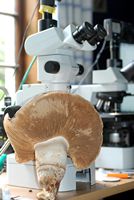
Caption: not a microfungus
Owner: J.A. Cooper | 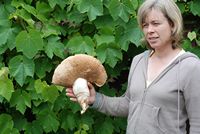
Owner: J.A. Cooper | 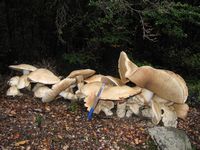
Owner: J.A. Cooper | 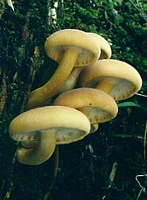
Caption: Agrocybe parasitica
Owner: Kaimai Bush | 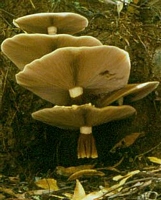
Caption: Agrocybe parasitica
Owner: Kaimai Bush | 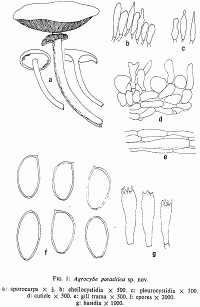 | 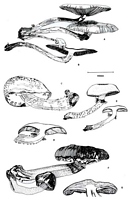
Caption: A. Cluster of 3 basidiomata and section (B), Taylor 702; C. Basidioma with primordium and section (D), Taylor 50; E. Section and basidioma, Taylor 52; F. Cluster of 2 basidiomata and section (G), Taylor 867. | 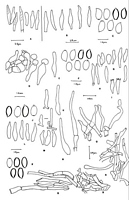
Caption: A-C Taylor 1365, A. Cheilocystidia; B. Pleurocystidia; C. Basidiospores; D-l Segedin 1732, D. Pileipellis; E. Pileocystidium; F. Basidiospores; G. Cheilocystidia; H. Pleurocystidia; 1. Basidia; J-N Segedin 1564, J. Basidiospores; K & N Caulocyst | 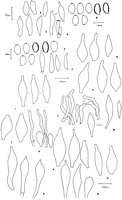
Caption: A-D Taylor 1370, A. Cheilocystidia; B. Basidiospores; C. Pleurocystidia: D. Basidium; E-F Taylor 1374, E. Basidiospores; F. Cheilocystidia; G-H Taylor 702, G. Cheilocystidia; H. Pleurocystidia. I. Pleurocystidia Taylor 52. J & N Taylor 50 J. Cheilocystidi | 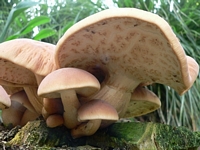
Caption: Immature fruiting bodies of Agrocybe parasitica with thick veil stretched to cover the maturing gills. Veil will soon break at margin and hang down on stalk, covered with brown spores as deposited from the gills prior to veil break
Owner: P.K. Buchanan | 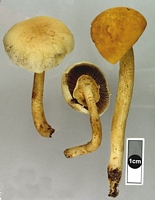
Owner: J.A. Cooper | 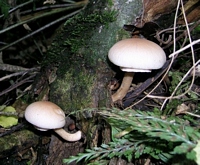
Owner: J.A. Cooper | 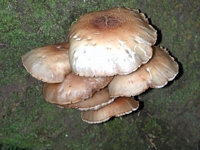
Owner: J.A. Cooper | 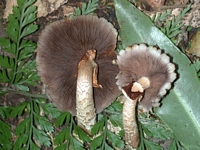
Owner: J.A. Cooper | 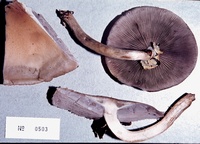
Caption: ZT0503
Owner: E. Horak: © Creative Commons Attribution-Noncommercial 3.0 New Zealand | 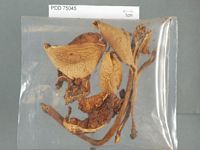
Caption: Dried type specimen
Owner: Herb PDD | 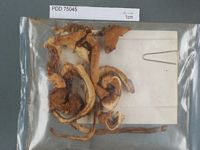
Caption: Dried type specimen
Owner: Herb PDD | 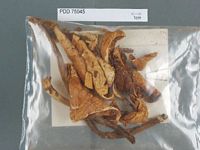
Caption: Dried type specimen
Owner: Herb PDD |
Article: Stevenson, G. (1982). A parasitic member of the Bolbitiaceae, Agrocybe parasitica sp. nov. New Zealand Journal of Forestry 27: 130-133.
Description: Pileus 5-25 cm diam. pale buff darker at centre to clay buff date brown at centre, plano-convex, dry velvety becoming smooth leathery, some with adhering velar remnants on the margins, flesh white firm. Gills adnexed to adnate, clay buff with conspicuous white margins, moderately crowded with many short members. Stipe 8-20 X 1-2 cm pale buff above ring clay buff or darker below, velvety, coarsely striate or with appressed scales, more or less equal, tough, flesh white above light brown below. Veil pressing against developing gills till the pileus is well expanded, falling free as a substantial superior pleated ring striated with a dark brown spore print. Spores 9-12.1 X 6-7 µm thick-walled with conspicuous germ pore, print umber. Smell strong sour.
Habitat: parasitic on certain hardwood trees in New Zealand — e.g., on standing dead B. tawa. Lake Papaitonga, Levin, 18.6.49, G.S.; on living B. tawa. Levin, 30.1.51, E. C. Parsons; on living P. betulinus, Ohau River, 26.1.52; on living M. ramiflorus, Totaranui, 12.4.55, both G.S.; on living Hoheria sp., Wairoa Gorge, 28.4.56, D. Read; on living B. tawa, Hutt Valley, 8.5.74; on standing moribund P. betulinus, Hutt Valley, 3.2.75; on Hoheria sp., and on P. betulinus, Kelburn Parade, Wellington, 7.3.75; on living Hoheria sp. growing from moth flight holes, Apiti, 24.4.78, all G.S.; on living A. excelsum. Lake Pounui, 13.5.78; on living Nothofagus solandri, Wainui-o-mata, 13.3.80; on C. laevigatus. Wairarapa, 25.4.80, all J. Grehan; on living L. novaezelandiae, Hutt Valley, 6.12.80, 1. Lewington; on living D. spectabile, Pukerua Bay, 21.6.81, G.S.; on recently felled P. betulinus, Riccarton Bush, 10.3.82, type, G.S.
Notes: This species is common throughout New Zealand and probably recognised by Colenso (1890) and Massee (1898) as Agaricus (Pholiota) pudicus. Indeed Colenso's record of Pholiota heteroclita (Fr.) Quel. may refer to the same species but the material (b 624) in K lacks basidiospores. It is an excellent edible mushroom very closely related to A. cylindrica ( DC.: Fr.) Maire, indeed at the start of the present study following Singer (1969) the present authors included it within their circumscription of A. cylindrica.
In addition Stevenson (1982 a & b) describes the same species on Alectryon excelsum Gaertn., Carpodetus serratus Forst., Corynocarpus laevigatus Forst., Dysoxylum spectabile Blume, Hoheria sp., Laurelia novaezelandiae A. Cunn., Nothofagus solandri Oerst. and Plagianthus betulinus A. Cunn. To this list can now be added Erythrina caffra. Leptospermum ericoides. Macropiper excelsum. Magnolia grandiflora Linn. (Univ. of Auckland), Metrosideros excelsa. Populus italica (Duroi) Muench. (Wynyard Car Park, Univ. of Auckland), Rhododendron and Senecio grandifolius Berg.
Thus A. parasitica has now been found on both native and introduced trees and would appear to be far commoner than A. cylindrica is in Europe which, although it has been recorded on several hosts, is much more restricted in its host preference. One record exists in New Zealand for A. parasitica on Ulmus glabra Huds., a host on which A. cylindrica is found in Europe. Illustrations of this species occur in Taylor (1981; 1983).
A. parasitica (as A. cylindrica) from Australia is illustrated by Macdonald and Westerman 1979 and Fuhrer 1985. Dr Fuhrer kindly sent a collection to Edinburgh for study and it confirmed our identification. Material examined: on Atherospermum moschatum. Talbot Drive, near Marysville, Vie., Australia, v 1985, B. Fuhrer B236. This may be the first record of A. parasitica in Australia, where it appears to be not uncommon in Victoria at least, and is probably widespread.
Singer (1969) synonymised Agaricus crassivelus Spegazzini (in Ann. Soc. Cienc. Argent. 9: 279, 1880), Pholiota formosa Spegazzini (in Bot. Acad. Cienc. Cordoba 28; 311, 1926) and Pholiota impudica Spegazzini (in Bol. Acad. Nac. Cienc. Cordoba ii» 414, 1889) with A. cylindrica (as A. aegerita) and recognised considerable variation within this taxon. He suggested that several taxa may ultimately be described in the complex. A. parasitica is just one such taxon; unfortunately during the present study Spegazzini's types were not examined and so it has not been possible to compare the microscopic characters demonstrated in our material with those published for the S. American taxa. However, collections from Brazil examined by one of us (RW) demonstrate that quite a different fungus is at least present there. Agaricus phylicigenus Berkeley from Tristan da Cunha is also claimed to be A. cylindrica (Singer, 1969), but the type in K is so badly preserved that it does not help to clarify the situation.
We have compared our material with the following collections of A. cylindrica from Europe (all in E) - The Netherlands; on Populus. Italy: on Ficus, Genova, Erbar Crittogam. Ital., Ser. II. British Isles: Petersham, Surrey, 27 v 1908, legit Hartley Smith; on Populus, Hereford, Ross-on-Wye. 29 x 1969, Orton 3503; on Acer campestre L., Archer Wood, Coppingford, Huntingdonshire, 5 v 1973, legit Sheila S Wells; on Populus, Offord, Huntingdonshire, 7 vii 1974, legit S. Wells; on Sambucus, Castor Henglands NNR, Cambridgeshire, 3 x 1976, legit S. Wells. Other material from the British Isles was examined during the preparation of the British Fungus Flora (Watling, 1982) and the data obtained there from has been used in this study.
In the Dutch and some English material on Populus the pleurocystidia are very rare, and the cheilocystidia vesiculose to ventricose and never with a long appendage. This is in fact parallel to material collected in Kashmir (on Populus alba L., Gulmarg, 28 ix 1978, Wat. 13067 in E & Abraham - 6RRL 7748 in E); see Watling & Gregory, 1980 and Watling & Abraham (ined.). In those British collections with abundant pleurocystidia these are always clavate, although often with a long pedicellate base, and subhymenial or even tramal in origin. In this way they resemble collections from Afghanistan (in garden, Kabul, 12 v 1951 legit Gehli; on Populus pyramidalis Rozier (= P. italica (Duroi) Muench) Kabul, 21 v 1951; both det. R. Singer in MICH), although the basidiospores of these agree more with A. parasitica (11-12 x 6-7 µm).
Thus whereas the European collections appear to be heterogeneous, those from New Zealand are uniform and characterised by the following cluster of characters;- relatively large basidiospores with small, although quite distinct germ-pore, elongate cheilocystidia and abundant development of pleurocystidia with long apical appendage.
Taylor 867 is notable in showing an excellent development of hyphal material from its bivelangiocarpic growth in parallel to the condition described for A. cylindrica by Reijnders (1979); however, this collection consists of immature basidiomes, judging from lack of spore-development; the basidiospores available are in fact comparatively small.
Some variation is found in the detailed structure of the pileipellis in the collections of A. parasitica but this simply reflects the state of maturity. At first the pileus is covered in hyphal strands under which a palisadoderm is formed; as the pileus expands these hyphae become intermixed with ellipsoid-pedicellate to spheropedunculate cells and at maturity are even joined by hyphae derived from the pileus-trama. This may explain the variation found in A. cylindrica where rugulose and smooth-capped forms occur but more critical notes are required on individual collections to ascertain the significance of such a character and whether it is correlated with other micro-data.
The variation in basidia, cystidial morphology and their abundance in Brazilian collections examined by one of us (RW) indicates that almost totally 2-spored forms are common there, 2- and 4-spored basidia were found on many of the New Zealand collections, e.g. Taylor 867, and in European collections from the Netherlands and from England (Orton 3503). Singer (1969) indicates that similar variation is found in the S. American collections he has examined, he also indicates that within these same collections of A. cylindrica (as A. aegerita) he found populations in which the basidiospores are "distinctly truncate whereas in others they are not, populations in which the pleurocystidia are acute and others in which the pleurocystidia are obtuse ventricose-ampullaceous, and populations which are exclusively 2-spored and others exclusively 4-spored.
As the basidiospores of members of the A. cylindrica group germinate so readily and the axenic cultures prepared fruit readily these agarics offer ideal subjects for the study of variation and interfertility. Esser and his colleagues (Esser, Semerdzieva & Stahl, 1974; Esser & Meinhardt, 1977; Meinhardt & Esser, 1981) have demonstrated the ways by which variability in European isolates can be studied, indeed they have analysed some 2-spored forms. Thus the conspecificity or autonomous nature of the various isolates in the A. cylindrica complex could be determined in parallel to the recent techniques used for analysing ranges of Armillaria isolates. A. cylindrica is in fact cultivated commercially in Europe; see Ferri, 1973.
Article: Watling, R.; Taylor, G.M. (1987). Observations on the Bolbitiaceae: 27. Preliminary account of the Bolbitiaceae of New Zealand. Bibliotheca Mycologica 117: 61 p. + 17 pl.
Description: Pileus 65-200 mm, convex to plano-convex finally plane, at first dark yellow brown to greyish brown ("snuff brown" "fulvous") then fading during expansion to buff with cinnamon tinge at disc, at length wholly whitish, smooth with a texture of close velvet becoming like chamois then naked on weathering, occasionally dimpled in age, often becoming cracked into areolae; margin entire, not striate, dotted with loose crumb-like particles whilst still inrolled. Stipe 110-150(-200) x 12-20 mm, cylindric to somewhat thicker downwards, annulate, white to pale buff with longitudinal lines of concolorous to brownish tiny squamules, surface occasionally cracking into recurved scales downwards; ring apical, membranous, pale buff, slow to detach from pileus-margin, collapsing into a full "flared skirt", ridged and striped above by longitudinal dark brown lines from spores and sprinkled below with crumb-like fragments similar to those on the young pileus margin, soft and collapsing in humid weather. Gills adnate with slight tooth, fairly crowded from many lamellulae, buff darkening to snuff-brown or umber, margin white, finely floccose-denticulate. Flesh white in pileus and stipe-apex, firm, a grey watery zone sometimes present above gills, browning towards stipe-base, tough-fibrous in stipe-cortex, more tenuous inside. Taste mild, pleasant; smell nutty, like yeast.
Basidiospores umber to date-brown in mass, (8.5-) 9.5 -12 x (5.5-) 6-6.5 µm, ellipsoid, slightly thick-walled, ochraceous brown in water, darker in aqueous alkali solutions, guttulate, non-amyloid, not strongly cyanophilic; germ-pore present, small. Basidia (2-)4-spored, clavate-cylindric. Cheilocystidia lageniform swollen below with short neck, to ampulliform, intermixed with ventricose cells, 18-35 x (7-)9-10 µm, hyaline or slightly honey-coloured in water and alkali solutions, in two collections masked by velar remnants; pleurocystidia present, prominent, fairly numerous, similar to cheilocystidia although neck sometimes longer (>6 µm), 24-40 x 6-11 µm, neck 3-5 µm broad. Hymenophoral trama regular, incolorous. Pileus trama with oleiferous hyphae; clamp-connections numerous. Pileipellis a palisadoderm through which hyphae 5-6 µm broad project, sometimes accompanied by cystidioid cells. Velar remnants at margin of pileus and edge of gills hyphoid, clamped, end-cells 28-36(-70) x 3.5-6 µm, intermixed with cystidia. Clamp connections present.
Habitat: Habitats gigantic clusters or singly, on introduced and native dicotyledonous trees especially tawa (Beilschmiedia tawa Benth. & Hook. f.) and kohekohe (Dysoxylum spectabile Hook. f.); common, widespread and almost certainly indigenous in New Zealand. It has not as yet been recorded on any gymnospermous host. It is found both on living hosts and those recently dead and sometimes fairly high above the ground. Basidiomata appear typically from wounds, being associated with a very slow heart rot, although it is probably only a secondary invader; but see Stevenson, 1982.
Notes: This species is common throughout New Zealand and probably recognised by Colenso (1890) and Massee (1898) as Agaricus (Pholiota) pudicus. Indeed Colenso's record of Pholiota heteroclita (Fr.) Quel. may refer to the same species but the material (b 624) in K lacks basidiospores. It is an excellent edible mushroom very closely related to A. cylindrica ( DC.: Fr.) Maire, indeed at the start of the present study following Singer (1969) the present authors included it within their circumscription of A. cylindrica.
In addition Stevenson (1982 a & b) describes the same species on Alectryon excelsum Gaertn., Carpodetus serratus Forst., Corynocarpus laevigatus Forst., Dysoxylum spectabile Blume, Hoheria sp., Laurelia novaezelandiae A. Cunn., Nothofagus solandri Oerst. and Plagianthus betulinus A. Cunn. To this list can now be added Erythrina caffra. Leptospermum ericoides. Macropiper excelsum. Magnolia grandiflora Linn. (Univ. of Auckland), Metrosideros excelsa. Populus italica (Duroi) Muench. (Wynyard Car Park, Univ. of Auckland),
Thus A. parasitica has now been found on both native and introduced trees and would appear to be far commoner than A. cylindrica is in Europe which, although it has been recorded on several hosts, is much more restricted in its host preference. One record exists in New Zealand for A. parasitica on Ulmus glabra Huds., a host on which A. cylindrica is found in Europe. Illustrations of this species occur in Taylor (1981; 1983).
A. parasitica (as A. cylindrica) from Australia is illustrated by Macdonald and Westerman 1979 and Fuhrer 1985. Dr Fuhrer kindly sent a collection to Edinburgh for study and it confirmed our identification. Material examined: on Atherospermum moschatum. Talbot Drive, near Marysville, Vie., Australia, v 1985, B. Fuhrer B236. This may be the first record of A. parasitica in Australia, where it appears to be not uncommon in Victoria at least, and is probably widespread.
Singer (1969) synonymised Agaricus crassivelus Spegazzini (in Ann. Soc. Cienc. Argent. 9: 279, 1880), Pholiota formosa Spegazzini (in Bot. Acad. Cienc. Cordoba 28; 311, 1926) and Pholiota impudica Spegazzini (in Bol. Acad. Nac. Cienc. Cordoba ii» 414, 1889) with A. cylindrica (as A. aegerita) and recognised considerable variation within this taxon. He suggested that several taxa may ultimately be described in the complex. A. parasitica is just one such taxon; unfortunately during the present study Spegazzini's types were not examined and so it has not been possible to compare the microscopic characters demonstrated in our material with those published for the S. American taxa. However, collections from Brazil examined by one of us (RW) demonstrate that quite a different fungus is at least present there. Agaricus phylicigenus Berkeley from Tristan da Cunha is also claimed to be A. cylindrica (Singer, 1969), but the type in K is so badly preserved that it does not help to clarify the situation.
We have compared our material with the following collections of A. cylindrica from Europe (all in E) - The Netherlands; on Populus. Italy: on Ficus, Genova, Erbar Crittogam. Ital., Ser. II. British Isles: Petersham, Surrey, 27 v 1908, legit Hartley Smith; on Populus, Hereford, Ross-on-Wye. 29 x 1969, Orton 3503; on Acer campestre L., Archer Wood, Coppingford, Huntingdonshire, 5 v 1973, legit Sheila S Wells; on Populus, Offord, Huntingdonshire, 7 vii 1974, legit S. Wells; on Sambucus, Castor Henglands NNR, Cambridgeshire, 3 x 1976, legit S. Wells. Other material from the British Isles was examined during the preparation of the British Fungus Flora (Watling, 1982) and the data obtained there from has been used in this study.
In the Dutch and some English material on Populus the pleurocystidia are very rare, and the cheilocystidia vesiculose to ventricose and never with a long appendage. This is in fact parallel to material collected in Kashmir (on Populus alba L., Gulmarg, 28 ix 1978, Wat. 13067 in E & Abraham - 6RRL 7748 in E); see Watling & Gregory, 1980 and Watling & Abraham (ined.). In those British collections with abundant pleurocystidia these are always clavate, although often with a long pedicellate base, and subhymenial or even tramal in origin. In this way they resemble collections from Afghanistan (in garden, Kabul, 12 v 1951 legit Gehli; on Populus pyramidalis Rozier (= P. italica (Duroi) Muench) Kabul, 21 v 1951; both det. R. Singer in MICH), although the basidiospores of these agree more with A. parasitica (11-12 x 6-7 µm).
Thus whereas the European collections appear to be heterogeneous, those from New Zealand are uniform and characterised by the following cluster of characters;- relatively large basidiospores with small, although quite distinct germ-pore, elongate cheilocystidia and abundant development of pleurocystidia with long apical appendage.
Taylor 867 is notable in showing an excellent development of hyphal material from its bivelangiocarpic growth in parallel to the condition described for A. cylindrica by Reijnders (1979); however, this collection consists of immature basidiomes, judging from lack of spore-development; the basidiospores available are in fact comparatively small.
Some variation is found in the detailed structure of the pileipellis in the collections of A. parasitica but this simply reflects the state of maturity. At first the pileus is covered in hyphal strands under which a palisadoderm is formed; as the pileus expands these hyphae become intermixed with ellipsoid-pedicellate to spheropedunculate cells and at maturity are even joined by hyphae derived from the pileus-trama. This may explain the variation found in A. cylindrica where rugulose and smooth-capped forms occur but more critical notes are required on individual collections to ascertain the significance of such a character and whether it is correlated with other micro-data.
The variation in basidia, cystidial morphology and their abundance in Brazilian collections examined by one of us (RW) indicates that almost totally 2-spored forms are common there, 2- and 4-spored basidia were found on many of the New Zealand collections, e.g. Taylor 867, and in European collections from the Netherlands and from England (Orton 3503). Singer (1969) indicates that similar variation is found in the S. American collections he has examined, he also indicates that within these same collections of A. cylindrica (as A. aegerita) he found populations in which the basidiospores are "distinctly truncate whereas in others they are not, populations in which the pleurocystidia are acute and others in which the pleurocystidia are obtuse ventricose-ampullaceous, and populations which are exclusively 2-spored and others exclusively 4-spored.
As the basidiospores of members of the A. cylindrica group germinate so readily and the axenic cultures prepared fruit readily these agarics offer ideal subjects for the study of variation and interfertility. Esser and his colleagues (Esser, Semerdzieva & Stahl, 1974; Esser & Meinhardt, 1977; Meinhardt & Esser, 1981) have demonstrated the ways by which variability in European isolates can be studied, indeed they have analysed some 2-spored forms. Thus the conspecificity or autonomous nature of the various isolates in the A. cylindrica complex could be determined in parallel to the recent techniques used for analysing ranges of Armillaria isolates. A. cylindrica is in fact cultivated commercially in Europe; see Ferri, 1973.
Article: Gadgil, P.D. (in association with Dick, M.A.; Hood, I.A.; Pennycook, S.R.) (2005). Fungi on trees and shrubs in New Zealand. Fungi of New Zealand. Ngā Harore o Aotearoa 4: xi + 437 p. Hong Kong: Fungal Diversity Press.
Description: Type: Caulicolous Fungi; Description: Basidiomata pileate, centrally stipitate. Pileus pale buff to brown, darker at centre, 40–200 mm in diameter, plano-convex to plane, smooth and leathery, dry; flesh firm, white. Gills adnexed to adnate, moderately crowded, buff to milky brown with conspicuous white sterile margins which are later stained brown with spores. Stipe pale buff above annulus, pale brown to brown below, striate, solid, 50–20 mm long; the substantial, brown, striate and pleated veil is at first held firmly against the developing gills, not falling free until the pileus is at least half expanded. Basidiospores broadly ellipsoid to ovoid, 9–12 × 6–7 μm; spore print cigar brown.
Distribution: Distribution: Northland, Auckland, Waikato, Bay of Plenty, Taranaki, Taupo, Wanganui, Wellington, Gisborne, Hawkes Bay, Wairarapa, Nelson, Mid Canterbury, South Canterbury.; 1st Record: Colenso (1891: as Agaricus (Pholiota) pudicus (see Watling & Taylor 1987)).
Article: Massee, G.E. (1899) [1898]. The fungus flora of New Zealand. Transactions and Proceedings of the New Zealand Institute 31: 282–349 Wellington:.
Description: Pileus fleshy, convex, then expanded, or even depressed, obtuse, even, dry, glabrous, white or
slightly tinged with tawny; 2.5-8 cm. across; gills adnexed, rounded behind, ventricose, about
4 mm. broad, whitish, then tawny; spores elliptical, 6-7 x 3.5 µ; stem 2.5-5 cm. long, 5-10
mm. thick, straight or most frequently curved and ascending, equal, even, white, solid; ring
superior, persistent, white, spreading.
Habitat: On trunks.
Distribution: New Zealand. Australia, Europe.
Notes: Simple or caespitose; stem sometimes excentric and curved at the base. According to
Bulliard's figure, quoted above, the pileus is pruinose at the disc.
|